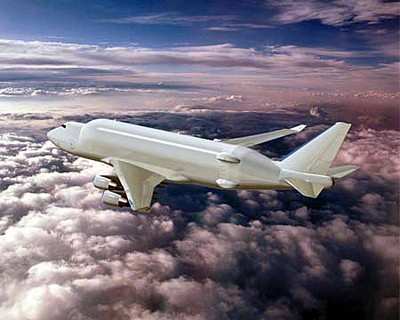Three Modified 747-400s Will Carry 787 Assemblies
 Boeing has selected Evergreen
Aviation Technologies Corporation (EGAT) to convert three 747-400
passenger jets into cargo freighters that will be used to transport
major assemblies for the Boeing 787 Dreamliner.
Boeing has selected Evergreen
Aviation Technologies Corporation (EGAT) to convert three 747-400
passenger jets into cargo freighters that will be used to transport
major assemblies for the Boeing 787 Dreamliner.
EGAT is a joint venture of EVA Air and General Electric. It's
part of Taiwan 's Evergreen Group. Boeing 787 Vice President of
Manufacturing and Quality Scott Strode joined EGAT Chairman David
Wang and EVA President K.W. Chang in Taipei Monday to formally sign
the modification services agreement. Financial terms aren't being
disclosed.
"The Large Cargo Freighter is a critical component of our 787
manufacturing plan," Strode said. "We're proud to partner with EGAT
on what is truly a one-of-a-kind Boeing airplane."
Initially Boeing will rely on two Large Cargo Freighters, with a
third to follow later. Boeing purchased the first two airplanes
last year. Modification of the first will begin at about mid-year.
The Large Cargo Freighter will be certified during 2006 and return
to service to support the final assembly of the first Dreamliners
in 2007.
Boeing has 191 announced firm orders and commitments for the 787
from 15 airlines.
David Wang, chairman of EGAT, said "today's agreement signals
EGAT's entry into the aircraft conversion business, a goal we have
pursued for some time. It furthers EGAT's reputation as a reliable
partner delivering the highest-quality work at exceptional
value."
Moving major 787 assemblies by air to the 787's Everett, Wash.,
final assembly facility could save 20 to 40 percent compared to
traditional shipping methods, and reduce delivery times to as
little as one day from as many as 30 today. Such savings will allow
Boeing to recoup its initial investment in the 747s during the
first few years of 787 production.

EGAT will modify the airplanes in its 127,464-square-foot
(11,685 square meters) maintenance hanger that opened in December
2004 at Taipei 's Chiang Kai-Shek International Airport. The
facility can accommodate a 747-400 aircraft and two narrow-body
jets at the same time.
"We're honored that Boeing has placed its trust in EGAT to
perform this important modification work," EVA's President K.W.
Chang said. "We're proud to join the team of partners around the
world who are contributing to 787 Dreamliner's success."
The Large Cargo Freighter's unique design will feature an entire
aft fuselage that swings open for loading. Modifications to enlarge
the upper fuselage will increase the volume of the main cargo deck
to 65,000 cubic feet (1,845m3), 300 percent more capacity than the
747-400 Freighter, the largest freighter in regularly scheduled
service.
Launched in April 2004, the 787 is a family of airplanes in the
200- to 300-seat class that will carry passengers on routes between
3,500 and 8,500 nautical miles (6,500 to 16,000 kilometers), such
as between Taipei and Dubai , Beijing to New York City , and
Shanghai to Los Angeles . The 787 will allow airlines to offer
passengers more of what they want: affordable, comfortable,
nonstop, point-to-point travel to more destinations around the
world.

The 787 will use 20 percent less fuel than today's airplanes of
comparable size, and provide airlines with up to 45 percent more
cargo revenue capacity. Passengers will find significant
innovations including a new interior environment with higher
humidity, wider seats and aisles, larger windows, and other
conveniences.
In addition to bringing big-jet ranges to mid-size airplanes,
the 787 will fly at Mach 0.85, as fast as today's fastest
commercial airplanes, while using much less fuel. The 787 family
offers two engine types, the General Electric GENX (GE Next
Generation) or Rolls-Royce's Trent 1000.
 Bolen Gives Congress a Rare Thumbs-Up
Bolen Gives Congress a Rare Thumbs-Up The SportPlane Resource Guide RETURNS!!!!
The SportPlane Resource Guide RETURNS!!!! Buying Sprees Continue: Textron eAviation Takes On Amazilia Aerospace
Buying Sprees Continue: Textron eAviation Takes On Amazilia Aerospace Hawker 4000 Bizjets Gain Nav System, Data Link STC
Hawker 4000 Bizjets Gain Nav System, Data Link STC Echodyne Gets BVLOS Waiver for AiRanger Aircraft
Echodyne Gets BVLOS Waiver for AiRanger Aircraft





